Five Multimedia Notebooks, Tested
3DMark Vantage
We don’t normally run 3DMark on conventional notebooks, but we thought it would be of interest for these multimedia units. Given their Windows Vista operating systems and mostly 8xxx class graphics circuitry, we thought they might perform better in this realm than other notebooks do. Given the heavily game- and motion-oriented nature of these benchmarks, their results often speak more to systems intended for serious gaming, animation or 3-D modeling. Nevertheless, their inclusion of DirectX10 coverage and a serious graphics workout make this a test of graphics capability.
Here’s a summary of the 3DMark Vantage results for its tests, which were conducted at 1024x768, 1280x1024 and 1920x1080 resolutions. The "low" values report results with no anisotropic filtering (AF) or anti-aliasing (AA) turned on; the "high" values report results with 4AA and 8AF. Values go down as resolution go up, and as AA and AF are turned on.
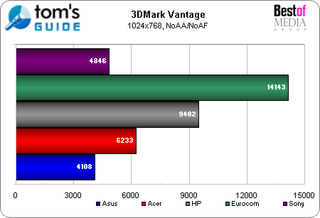
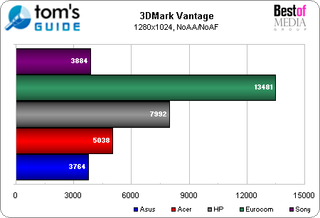
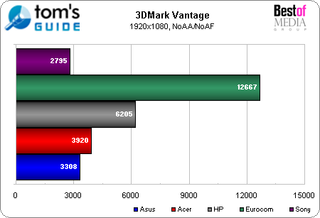

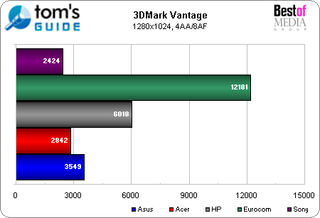
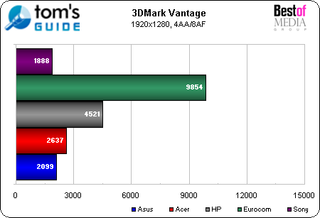
By any measure of 3D, the Eurocom is a real screamer—as you’d have to expect from an SLI rig with a quad-core CPU. If you check out the various score posting forums, you’ll see that any score over 10,000 is at least respectable and the Eurocom manages to deliver those numbers at all but the most demanding setting. The HP pulls in a decent second place finish (even for a desktop), with the Acer solidly in third. What we also find interesting is the way the Sony changes places with the Asus at 1920x1080 resolution for both high and low settings. Go figure.
Stay on the Cutting Edge
Join the experts who read Tom's Hardware for the inside track on enthusiast PC tech news — and have for over 25 years. We'll send breaking news and in-depth reviews of CPUs, GPUs, AI, maker hardware and more straight to your inbox.
-
urimiel I am really sorry to be the one that points this out. I am Tomshardware reader for quite many years now. This is the first time I have seen an article or any kind of presentation like that. You guys are posting bar graphs and change the legend of each color bar for every different graph... this does not make sense.Reply -
fudgeboy ReplyYou guys are posting bar graphs and change the legend of each color bar for every different graph
wow, and thats like the basic fundamentals of presentation. the writers on this site really need to go back to high school. they should have a standard layout over the whole thing (like you would if you were doing an experiment) -
Master Exon Basically purple is always at the top, regardless of who purple represents. Kinda dumb, but they really should have had the manufacturer's name on the bar itself.Reply
Hey, when will TH compare $300-$450 netbooks? You already did the $2000 ones. -
cangelini urimielI am really sorry to be the one that points this out. I am Tomshardware reader for quite many years now. This is the first time I have seen an article or any kind of presentation like that. You guys are posting bar graphs and change the legend of each color bar for every different graph... this does not make sense.Reply
Heya guys--sorry about that. I should have caught this in editing. The charts are now correct with each notebook appearing in the same place with the same corresponding legend data. -
FrozenGpu Master ExonBasically purple is always at the top, regardless of who purple represents. Kinda dumb, but they really should have had the manufacturer's name on the bar itself.Hey, when will TH compare $300-$450 netbooks? You already did the $2000 ones.Reply
Pretty pretty please with a cherry on top? -
TheGreatGrapeApe To me the $300-450 laptops aren't worth an in depth review, just a quicky 2 pager (is it capable as a netbook yes/no) that's a disposable laptop you buy a kids or as a couch laptop or travel one.Reply
I want to know what my $2K+ buys me, the $300 laptop is the price of one of the options on these things. That's the bigger risk. What's anyone really expecting in a $300-400 laptop, certainly not heaving gsaming, video editing or programming.
It may seem elitist, but with the limited amount of info out there on laptops period, netbooks shouldn't consume much of the reviews time, nor space, I'd rather see more $1,000 and $2,000 and then $3,000+ reviews those 3 categories have more variability and value than the cheapest ones. Who can't figure out if a $400 laptop is worth it from a visit to the best buy or whatever?
Personally I want to see an IBM W700 review, tell me if it's worth the $3,000+ (is the built in Wacom pad good enough, the keyboard stiff enough, is it worth it to get turbo memory now that it's faster & bigger or just go SSD and be done with it, etc), not something to tell me which of the cheap laptops is slower than my previous laptops that you could buy at a discount store for as much and which might be just a tiny bit faster but still just suited for M$ office and websurfing and light photoshoping.
-
Is the image for this on the Toms Hardware site supposed to say "Multiedia" on the laptop screen or is that a typo?Reply
-
johntmosher I have been wanting to find a 20 inch laptop so I was excited to see the HDX review.....But still can't find it for sale online at HP.COMReply
Got a sales link? -
maric423 johntmosherI have been wanting to find a 20 inch laptop so I was excited to see the HDX review.....But still can't find it for sale online at HP.COMGot a sales link?Reply
According to the HP Sales guys, its out of production (I got interested and looked for it too). The replacement machine is supposedly the HP HDX 18t, which is only an 18.4", and doesn't have the same hinge structure. Not really a comparable machine. You can still find a few HP Pavilion HDX 20" from third parties if you search around, but I wasn't thrilled about the idea of buying a system they'd already stopped making. -
Can you please test one more little thing? Linux compatibility.Reply
Its easy, just toss in an ubuntu live CD, and tell us if things like sound, webcam, wifi etc work out of the box. If they don't, don't bother much trying to get it to work. But Acer for instance is notorious for having buggy ACPI implementation in the bios that detects the OS and only work with Vista. With Linux (possibly even XP) standby will be highly unreliable. Dell and IBM do a much better job at it, and that deserves to be known.
Doing such tests should be very straightforward and accomplish two things:
1) inform us linux users (we buy notebooks too you know :) )
2) put some pressure on oem's to test their BIOS and hardware with linux
Id appreciate it. No one does this, please be the first :)
Most Popular

